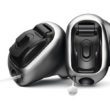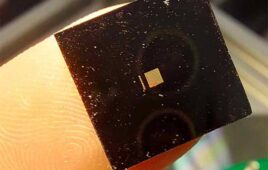
The Ormia ochracea is a small, yellow parasitic fly with an amazing sense of directional hearing that’s second to none in the animal kingdom. [Image from Ken Jones]
“These flies have highly specialized ears that provide the most acute directional hearing of any animal,” said Andrew Mason, a professor of biology and UT Scarborough, in a press release. “The mechanism that makes their hearing so exceptional has even led to a range of bio-inspired technology, like the mini directional microphones used in hearing aids.”
The Ormia fly can be found in the southern U.S. and Mexico. It uses its hearing to find male crickets to deposit its larvae. The larvae burrow inside the cricket and eat it alive.
Its mechanically-coupled ears help it become this tiny predator. It has two separate ears with both eardrums connected together like a seesaw with a rigid joint in the middle that bends. If one eardrum vibrates, it pushes the other eardrum to allow the fly to determine which direction the sound came from.
“It’s interesting that something so small can be sensitive to the direction of sound,” said Mason. “They’re tiny relative to the wavelength of sound they’re able to localize, so they shouldn’t be able to do what they do but they can because of the mechanical coupling.”
Hearing aid engineers are interested in using the same mechanism in the Ormia’s ear to make artificial sensors that better locate signals.
However, one of the problems engineers face is how to improve signal detection in noisy environments. Traditionally, animals use spatial release from masking (SRM) to detect a separation from what they want to hear and distracting noises.
“If the distracting noise is farther away from the interesting signal, then it causes less interference,” said Mason.
Ormia’s hearing system doesn’t use SRM, according to the researchers. They found that if a distracting noise occurred that wasn’t the cricket, the fly was able to divert the sound away. Since it has an extremely directionally-sensitive hearing, noise happening on one side can conceal the signal in one ear.
“A distracting noise that is more to one side will cause an auditory illusion by obscuring the signal in that ear,” said Mason. “It essentially ends up fooling the fly into perceiving that the signal is coming from one place, so it ends up pushing it away from the actual cricket sound.”
The researchers are also planning to investigate what limitations mechanical-coupled hearing systems have. They want to figure out how the flies can navigate more complex situations where it is receiving multiple signals in noisy conditions.
“These flies are very accurate for one thing, which is detecting cricket sounds, but that comes at a cost since they’ve evolved to focus on this very restrictive set of information,” Mason said.
The research was supported by the Natural Sciences and Engineering Research Council of Canada (NSERC) and is going to be published in the biology journal eLife.
[Want to stay more on top of MDO content? Subscribe to our weekly e-newsletter.]






